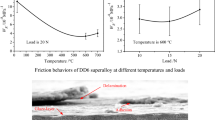Abstract
Solid lubricants are used to lubricate the mechanical equipment of various spacecraft and launch vehicles. Tungsten disulfide (WS2) is one of the solid lubricants that can be used in a variety of applications at elevated temperatures in outer space. In this study, WS2 coatings on a metal disc were applied via the shot peening method using WS2 powder (diameter of 2.0 μm). Friction experiments were carried out to investigate the friction characteristics of WS2 using a pin-on-disc-type rotary tribometer at high temperature in a vacuum. The friction coefficients of the WS2 shot peening coating were extremely low at room temperature and increased with the test temperature. Nevertheless, WS2 coatings demonstrated superior frictional properties at elevated temperatures and thus they are applicable at 400 °C in vacuum. All WS2 specimens showed a preferred orientation of the (0002) basal plane parallel to the disc surface. Atomic arrangements of the second nearest neighbor atoms were distorted from the original sites during the wear process. The room temperature friction tests of the shot peened WS2 specimen, annealed at 400 °C, demonstrated that the friction coefficients of the specimen with a higher degree of planar alignment on the (0002) plane were larger than those of the specimens with planner imperfections. Lattice defects such as stacking faults and dislocations assisted in the sliding motions of the adjacent sulfur atoms on the (0002) plane by extremely low shear stress.
Graphic Abstract













Similar content being viewed by others
References
Fusaro R.L.: Lubricant of Space System. NASA/TM-1994–106392 (1994)
Peter, M.: Magie: A Review if the Properties and Potentials of the New Heavy Metal Derivative Solid Lubricant. Lub. Eng Wiley, New York (1966)
Roberts, E.W.: Ultra low friction films of MoS2 for space applications. Thin Solid Films 181, 461–473 (1989)
Brainard, W.A.: NASA Technical note. NASA TN D-5141, (1969)
Watanabe, S., Noshiro, J., Miyake, S.: Friction properties of WS2/MoS2 multilayer films under vacuum environment. Surf. Coat. Technol. 188–189, 644–648 (2004)
Ratoi, M., Niste, V.B., Walker, J., Zekonyte, J.: Mechanism of action of WS2 lubricant nanoadditives in high-pressure contacts. Tribol. Lett. (2013). https://doi.org/10.1007/s11249-013-0195-x
Prasad, S., Zabinski, J.: Hollow nanoparticles of WS2 as potential solid-state lubricants. Nature 387, 761–763 (1997)
Rapoport, L., Leshchinsky, V., Lvovsky, M., Lapsketr, I., Volovik, Yu., Feldman, Y., Popovitz-Biro, R., Tenne, R.: Superior tribological properties of powder materials with solid lubricant nanoparticles. Wear 255, 794–800 (2003)
Gustavsson, F., Svahn, F., Bexell, U., Jacobson, S.: Nonoparticle based and sputtered WS2 low-friction coating: differences and similarities with respect to friction mechanisms and tribofilm formation. Surf. Coat. Technol. 232, 616 (2013)
Gustavsson, F., Jacobson, S.: Diverse mechanisms of friction induced self-organisation into a low-friction material: an overview of WS2 tribofilm formation. Tribol. Int. 101, 340–347 (2016)
Takahashi, A., Hashimoto, K.: Tribological characteristic evaluation of tungsten disulfide solid lubrication films. In: The 29th International Symposium on Space Technology and Science (ISTS2013), 2013-c-32 (2013)
Takahashi, A., Hashimoto, K.: A study of friction mechanism of tungsten disulfide at elevated temperatures using IPXRD. In: International Tribology Conference (ITC 2015) (2015)
Takahashi, A., Hashimoto, K.: Evaluation of frictional properties of tungsten disulfide bonded films at high temperature in vacuum environments. Nihonkinzokugakkaishi 80(4), 289–296 (2016)
Bunker, G.: Introduction to XAFS: A Practical Guide to X-Ray Absorption Fine Structure Spectroscopy. Cambridge University Press, Cambridge (2010)
Kimura, M., Takeichi, Y., Murao, R., Obayashi, I., Hiraoka, Y., Liu, Y.: In situ observation of reduction kinetics and 2D mapping of chemical state for heterogeneous reduction in iron-ore sinters. J. Phys. Conf. Ser. 712, 012077–012081 (2016)
Koningsberger, D.C., Prins, R. (eds.): X-Ray Absorption: Principles, Applications, Techniques of EXAFS, SEXAFS and XANES. Wiley, New York (1988)
NIST X-ray Photoelectron Spectroscopy Database. http://srdata.nist.gov/xps/.
Ng, K.T., Hercules, D.M.: Studies of nickel-tungsten-alumina catalysts by X-ray photoelectron spectroscopy. J Phys. Chem. 80(19), 2094–2102 (1976)
Salvati, L., Jr., Makovsky, L.E., Stencei, J.M., Brown, F.R., Hercules, D.M.: Surface spectroscopic study of tungsten-alumina catalysts using X-ray photoelectron, ion scattering, and Raman spectroscopies. J. Phys. Chem. 85(24), 3700–3707 (1981)
Amelinckx, S., Delavignette, P.: Dislocations in layer structures. In: Nwwkirk, J.B., Wernick, J.H. (eds.) Direct Observation of Imperfections in Crystal. Wiley-Interscience, New York (1962)
Takahashi, N., Shiojiri, M., Enomoto, S.: Direct resolution of the layer lattice of molybdenum disulphide by transmisssion electron microscopy in relation to lubrication. Wear 146, 107–123 (1991)
Shiojiri, M., Isshiki, T., Enomoto, S., Kobayashi, E., Takahashi, N.: High-resolution electron microscopy observations of the layer structures and stacking faults in molybdenite crystals. Phil. Mag. A 64, 971–980 (1991)
Isshiki, T., Nishio, K., Aoyagi, I., Yabuuchi, Y., Takahashi, N., Saijo, H., Shiojiri, M.: High resolution electron microscopy of layer structure and stacking faults in tungsten disulphide lubricants. Wear 170, 55–61 (1993)
Takahashi, A., SS, J.T., Hashimoto, K.: Evaluation of friction characteristics and low friction mechanism of tungsten disulfide for space solid lubricant at elevated temperature in a vacuum. In: 44th Aerospace Mechanism Symposium (AMS), (2018)
Acknowledgements
The authors wish to thank to Drs. K. Matsumoto and H. Shiomi of Japan Aerospace Exploration Agency (JAXA) for their technical assistance and helpful discussion. The WS2 substrate was prepared by Japanese Lubricant Ltd. Experiments using synchrotron radiation were performed under the approval of the Photon Factory in KEK Program Advisory Committee (Proposal Nos. 2015S2-002 and 2016S2-001). Parts of the study performed by Y.T. and M.K. were supported by the Cross-Ministerial Strategic Innovation Promotion Program (SIP, units D66) operated by the Cabinet Office of Japan. We would like to take this opportunity to express our sincere thanks to all the cooperators. This research was supported by the Grant-in-Aid for Young Scientists (19K15442) of the Japan Science and Technology Agency (JST), Japan.
Author information
Authors and Affiliations
Corresponding author
Additional information
Publisher's Note
Springer Nature remains neutral with regard to jurisdictional claims in published maps and institutional affiliations.
Rights and permissions
About this article
Cite this article
Takahashi, A., Takeichi, Y., Kimura, M. et al. Low Friction Mechanism Survey of Tungsten Disulfide by Using XRD, XPS, and XAFS. Tribol Lett 69, 84 (2021). https://doi.org/10.1007/s11249-021-01428-8
Received:
Accepted:
Published:
DOI: https://doi.org/10.1007/s11249-021-01428-8




